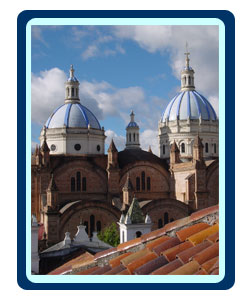Some Information about Cuenca
Nestled in the Andes mountain range and fed by 4 rivers, Cuenca is Ecuador's third largest city and arguably its most beautiful. The city has a population of nearly 300,000 people, but Cuenca feels much smaller and the town center is easily manageable on foot. If you get tired of walking, taxis are inexpensive and plentiful. A ride should cost between $2-$3 dollars.

In 1999, UNESCO nominated Cuenca a world heritage center for its incredible archictecture, indigenous influence and artistic spirit. I'm sure you'll enjoy wandering around the streets admiring the different styles of buildings and churches. Be sure to look for exposed stone in the walls of some of the buildings and churches. This indicates the Incan and Canari stone foundations that the Europeans used for planning the present day city.
Below, I will include useful information. My sister gave me the wise advice to keep description to a minimum, because I can be a little too verbose. However, I'll provide a link  to my first impression of the city from a letter that I wrote to my father in 1999. to my first impression of the city from a letter that I wrote to my father in 1999.
The photograph to the left shows Cuenca's main cathedral.
Weather
Because Ecuador is located on the equator, most people think that Cuenca will have a tropical climate. However, at over 8,000 feet above sea level, Cuenca has a mild climate during the day and can become a little chilly during the night. Temperatures during the day range from 60-80 degrees fahrenheit. At night, temerperatures range from 45-65 degrees.
As for what clothes to wear, you will probably be perfectly comfortable in a t-shirt or short-sleeved shirt and jeans or pants during the day. At night, you will need a sweater and perhaps a jacket or coat. Keep a sweater, jacket or fleece with you during the day, because it can get a little cool when the sun dips behind the clouds.
However, you should remember that the weather depends on the altitude. If you go down to the coast or to Vilcabamba or Baños, the weather will be much warmer because those places are at a lower altitude. In Baños or Vilcabamba, you'll probably want shorts and t-shirts. At night, you might want a light jacket or fleece. The coast is hot period.
Costs
The prices in Ecuador have risen over the past five years, but everything is still much cheaper in Ecuador than the United States. A lunch should cost you between $2-$10. Dinner at a nice restaurant could cost anywhere between $6-$15. Five years ago, Ecuador dollarized its economy, meaning that they gave up their national currency for the United States dollar. While this is very sad for the Ecuadorian people and has enormous consequences on the national economy, it also means that you won't have to exchange money.
Internet
If you don't have internet available in your hotel, there are many internet cafes throughout the center of the city. Connection speeds depend on the cafe, but you can find some very fast internet connections. Prices for internet usage are inexpensive, ranging from $1-$2 an hour.
Safety and Health Precautions
Cuenca is a very safe town, but Ecuador has experienced a number of economic problems in the last five years. As a result, pickpocketing and purse snatchings are not uncommon. Keep your camera or electronic goods in a pocket or out of sight when you are not using them. Fanny packs are very easy targets for pickpocketers I've heard. Another good advice is to only take the money that you will need that day and leaveyour credit cards and the rest of your money in the safe at the hotel room or locked in your bags. At night, you should always take a taxi.
As for health, Cuenca is located at a high enough altitude that you will not have to worry about many of the diseases common in tropical climates such as malaria. Cuenca is also the only city in Ecuador that purifies its water, which means that locals often drink the water out of the tap and food is generally more sanitary. This, however, does not mean that you should do the same. In fact, you should never drink the water out of the tap. You should also never eat raw fruit or vegetables unless they have been peeled. Most of Ecuador's tropical fruit, such as Tomate de Arbols (tree tomatoes), babaco (a type of melon) and Maracuya (passionfruit) have to be peeled. Still, if you are craving raw fruit and vegetables, you can use a product sold in the grocery stores which kills all harmful bacteria (this is what I did when I lived in Cuenca). You can normally find the product next to the vegetables in a Supermaxi (the local supermarket).
Apart from that, check with your doctor for the immunizations that you will need. As for medicine and healthcare, there are a number of very good hospitals and clinics in Cuenca. You can find most medicine at the pharmacies. I knew a 74 year old American couple living in Cuenca who lost all of their medications. They were able to replace all of their medicine at the local pharmacies and at a lower price. Things like cipro are commonly available at the pharmacies.
Above all, I think you will find Ecuadorians very helpful and hospitable.
|
